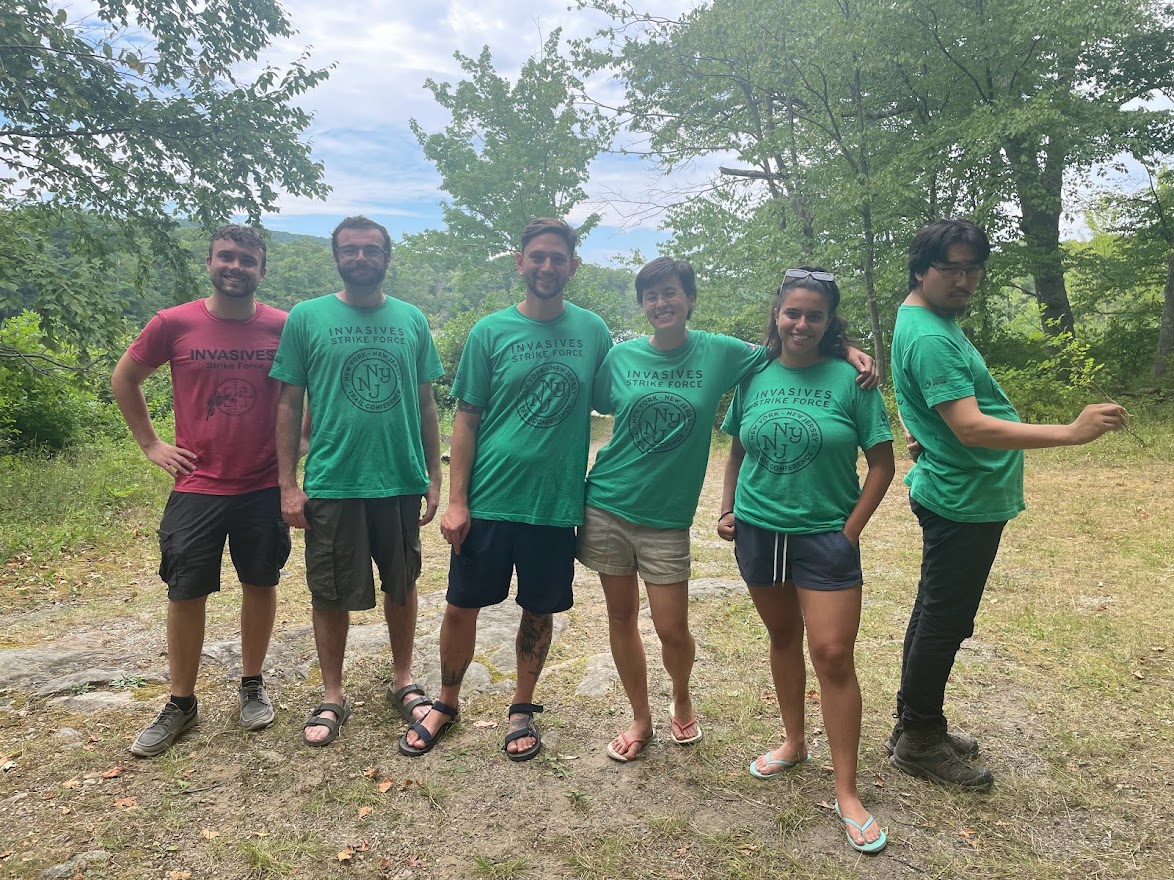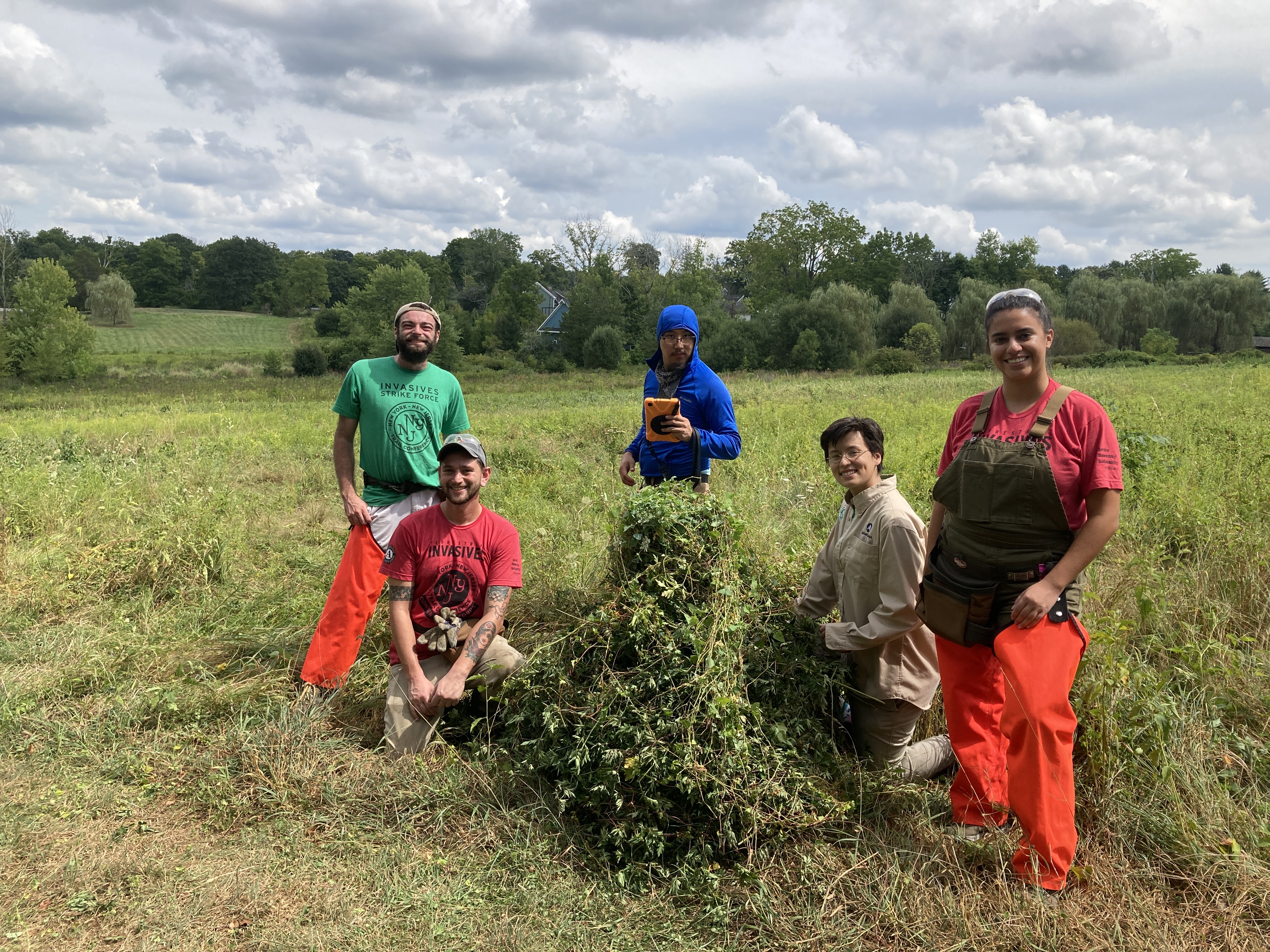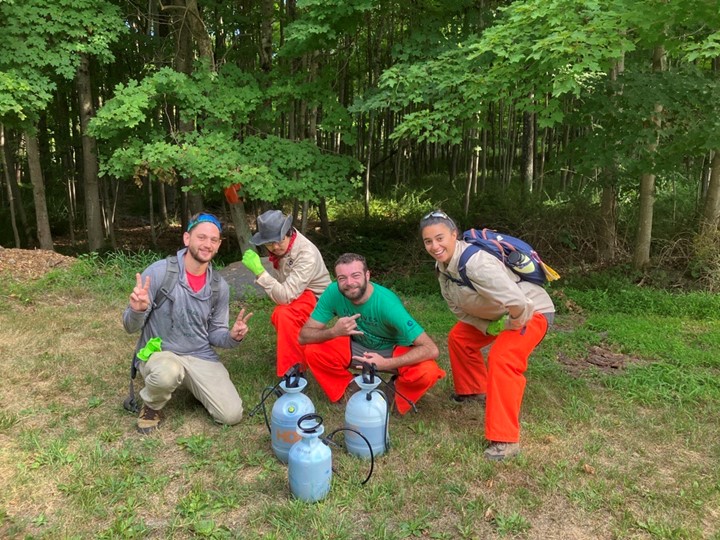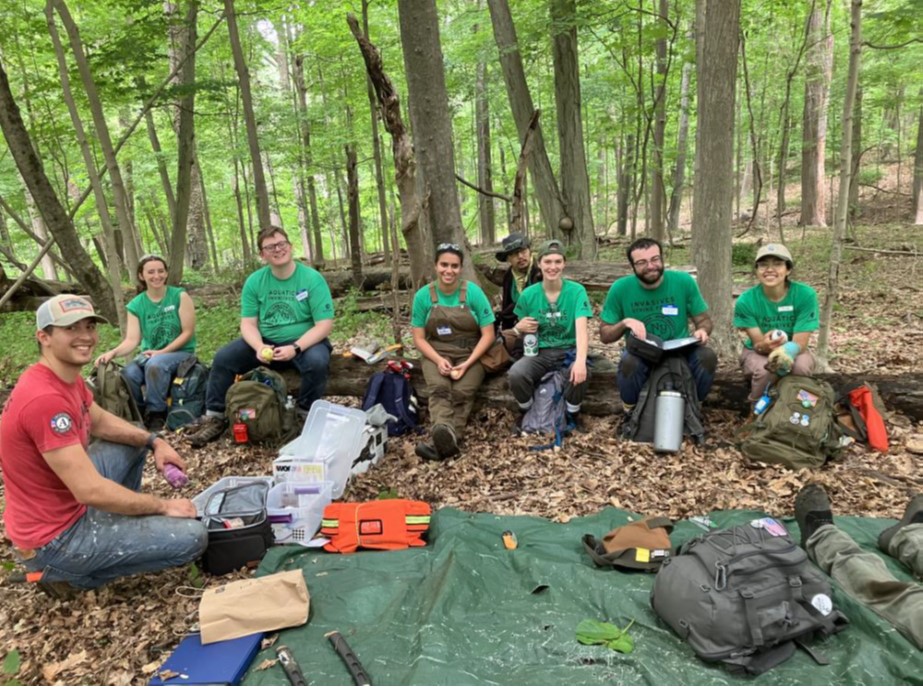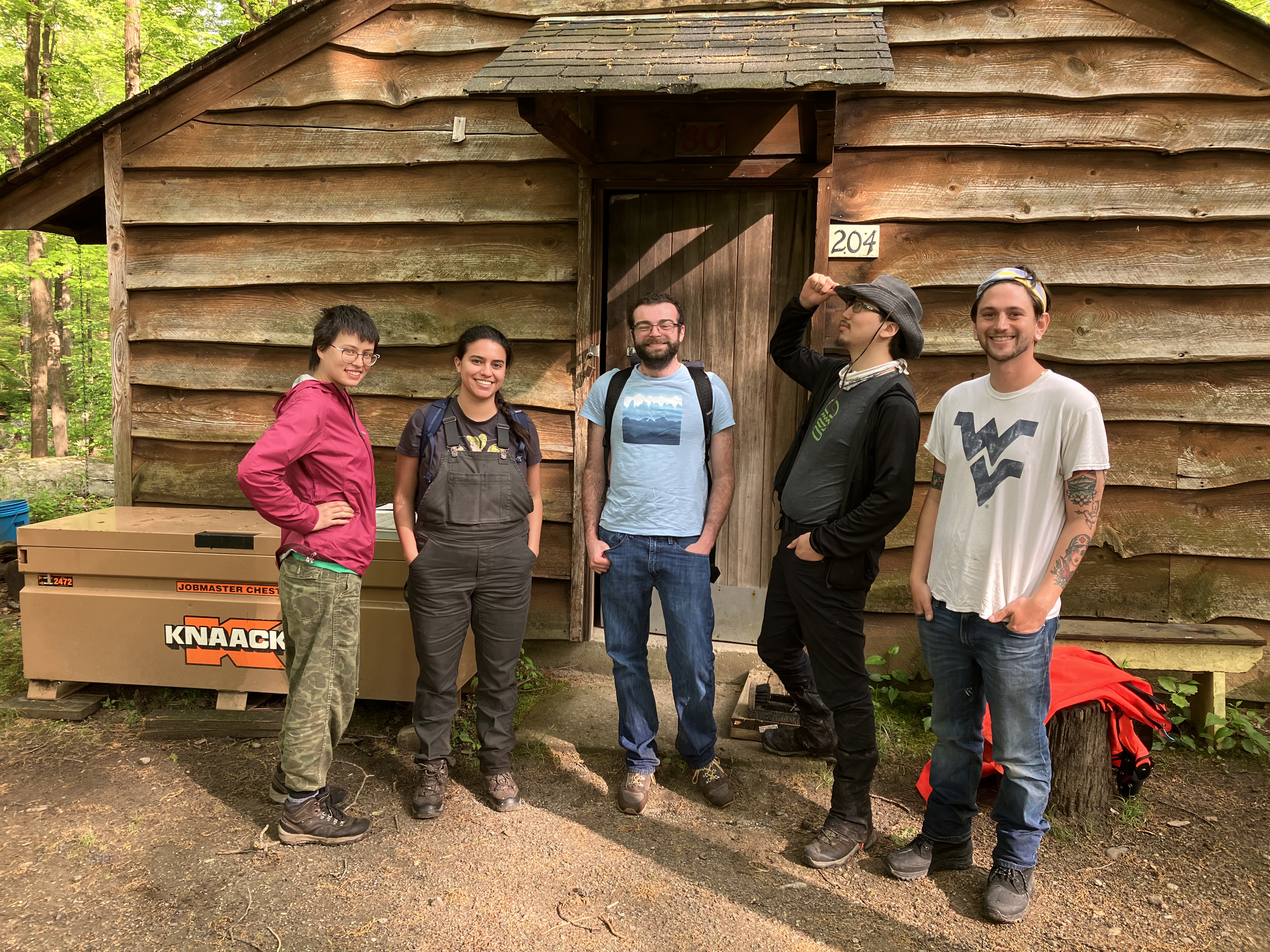The Invasives Strike Force (ISF) crew, as part of the Trail Conference Conservation Corps and funded through the Lower Hudson PRISM, is a conservation-based crew devoted to eradicate, contain and prevent the establishment of emerging terrestrial invasive species within the Lower Hudson Valley in order to protect our high-value habitat through the use of skilled labor within the region.
Table of Contents
by Claire Lignac, Invasive Strike Force Crew Leader
It’s spooky season, and the Strike Force is haunted by the nefarious kudzu (Pueraria montana) and the witchy Scotch broom (Cytisus scoparius) that climbs not only into the backyards of unsuspecting landowners, but also into our nightmares.
We spent four days this month working on the infamous kudzu vine. Nicknamed “the vine that ate the south” it was originally planted intentionally by the US government in the early 1900’s for erosion control and livestock feed. Kudzu’s rampant growth was eventually too much to manage, and it consumed so much of the landscape that descriptions of the south quickly became synonymous with kudzu. As James Dickey wrote,
“In Georgia, the legend says
That you must close your windows
At night to keep it out of the house
The glass is tinged with green, even so.”
The government eventually labeled it as a noxious weed in 1998, but it had already been established in much of the south and is now starting to nibble at the north. The ISF is working hard to prevent the north from succumbing to the clutches of kudzu. We managed 70,711.5 dense sq ft of kudzu this month, visiting 27 sites and surveying 7.6 acres of land.
We also visited Bear Mountain State Park where we were haunted by the ghost of invasives past, Scotch broom. Instead of thousands of tiny saplings, we were yanking up large shrubs and digging out the more stubborn plants with pick mattocks. 2066 large shrubs were removed in a previously untreated area, removing that seed source and making room for natives to populate the understory.
We had some additional events this month including volunteering with the Wild Woods Restoration Project to restore the habitat in Black Rock Forest by planting natives in the forest and along the trails from locally collected seeds. We also took a field trip to Lord Stirling Park to chat with a naturalist and learn about the intricacies of their job. It was cool to hear about the different programs they implemented to engage the community while taking a night hike and learning different owl calls! Thanks to Ben Barkley for sharing your knowledge of the field with us! After that, we had a meeting for the Lower Hudson Partnership for Regional Invasive Species Management to discuss updates on different land stewardship issues such as beech leaf disease, deer management, spotted lanternfly, as well as a demonstration from our very own Conservation Dogs team led by Arden!
We are proud of the work we have done this year surveying almost 500 acres and treating 79,000 plants over 100 acres of invasive infested soil! Thanks to the Trail Conference and AmeriCorps for giving us this opportunity, and thank you to all our partners for a great season!
School is in session, and the Invasives Strike Force has some lessons to teach some invasive species.
This month, we revisited our FRoG friends at the Great Swamp and cleared out 3,317 widespread invasives including oriental bittersweet (Celastrus orbiculatus), Japanese barberry (Berberis thunbergii), border privet (Ligustrum obtusifolium), etc. This will hopefully make way for native restoration efforts to provide better habitat for the endangered New England cottontail (Sylvilagus transitionalis). Thank you to Maryanne, Jim, and John for all your help!
We also went to Read Wildlife Sanctuary to clear out castor aralia (Kalopanax septumlobus) and cut-leaf blackberry (Rubus laciniatus), Brinton Brook to manage hardy kiwi (Actinidia arguta), and back home to Harriman State Park to manage Scotch broom (Cytisus scoparius).
We also visited Cary Institute for Ecosystem Studies to remove chocolate vine (Akebia quinata) and Japanese spiraea (Spiraea japonica). We noticed during our work that the understory was lush with native species which is relatively rare since the deer browse is so intense in New York. This is due to their annual deer hunts to control the population and the result is a beautiful, diverse understory full of natives. While the natives were thriving, the invasives were dying as we only found 114 Japanese spiraea and 48 chocolate vine individuals which is a decline from last year’s population. Thank you to Mike from Cary for showing us around!
This was our last trek to Dover, but not for sticky sage (Salvia glutinosa) this time. This time, we went out to a National Public Lands Day event run by Stancy DuHamel to manage various invasives across 7+ sites in Dover, NY. Our site was managing Japanese spiraea on the Appalachian Trail and we pulled 651 plants, clearing the infestation that ran closest to the trail so hopefully the seeds will be less likely to spread across the east.
The ISF worked on some special projects with Mahwah Environmental Volunteer Organization (MEVO), Catskills crew, and Iona Island. The entire Conservation Corps team banded together to volunteer at MEVO where we worked with their Fresh Roots Farming Program to harvest crops and turn over the soil for the fall growing season. It was fun and informative learning about the different sustainable growing principles like permaculture, low till practices, and bio intensive growing. We were also invited to a BioBlitz on Iona Island where we spent the day surveying Iona and identifying as much wildlife as we could. In the 24 hours of the blitz, there were over 400 observations with over 200 species identified! We also had the opportunity to join the Catskill Stewards early this month to help steward Slide Mountain, Giant Ledge, and High Point. Not only were there gorgeous viewpoints when looking out, but also a beautiful native understory when looking down. It was nice to learn about the rich history of the trails while meeting interesting hikers!
Next month we are wrapping up the field season, but there still much work to be done managing invasives and even possibly a naturalist field trip? Stay tuned!
This month, ISF got down to business with sticky sage (Salvia glutinosa) spending 2 weeks this month in Dover. This was our final push to suppress the sticky sage population before it goes to seed. We managed the outer edges of the infestation and pushed the population inwards to isolate it and hopefully prevent it from pushing out beyond the scope of our treatment area. We also had the opportunity to work with Arden and the conservation dogs while they sniffed out sticky sage. We are extremely proud of our accomplishments in Dover; in total, we searched 347 acres of land and treated 24,415 plants!
This month, we visited two sites that the ISF have been managing for a while: Shrub Oak Memorial Park and High Tor State Park. At Shrub Oak, we managed a shrinking population of small carpetgrass (Arthraxon hispidus) and even found some native horsetail, deertongue (Dichanthelium clandestinum), goldenrod, and American jumpseed (Persicaria virginiana) creeping in where the carpetgrass monoculture used to be. At High Tor, we managed black and pale swallowwort (Vincetoxicum nigrum and Cynanchum louiseae) or more colloquially named: the dog strangling vine. We started managing this population in High Tor State Park in 2014 and after 8 years of management, we have started to see the fruits of our labor in the absence of swallowwort! These projects visually showed us the impact of our work over the years and how continual management leads to regional eradication.
We also saw some familiar faces this month revisiting Vassar College and Iona Island. We met back up with our friends at Vassar College to take on a new foe, the white poplar tree (Populus alba) and managed a dense stand that was shading out natives in the area. At Iona Island, we finished up managing the cutleaf blackberry (Rubus lacinius) and scouted most of the island trekking 28.5 acres of land that day.
At the end of the month, we spent some time in Westchester County and had the opportunity to camp at Ward Pound Ridge Reservation while we worked! We visited Mianus River Gorge and managed 2023 individuals including tall sapphireberry (Symplocos paniculata) trees and dense mats of yellow archangel (Lamium galeobdolon). We also visited Pine Croft Meadow Preserve to manage isolated populations of cutleaf blackberry and fishpole bamboo (Phyllostachys aurea). Lastly, we visited the Halmi Preserve to manage a dwindling patch of chocolate vine (Akebia quinata) made up of only 137 individuals. This population has significantly decreased from last year’s 5000 sq ft of dense chocolate vine. Thanks to Budd and John for your help with management!
Next month, we are visiting some old friends in the Great Swamp and Dover as well as managing at some new locations such as the Cary Institute and Brinton Brook! Stay tuned!
In the Belly of the Whale
The ISF is deep within the belly of the invasive infestations as we make our way across the Lower Hudson Valley. Our first projects revisited long lost foes at Iona Island and Dover. We enlisted the help of the Hudson Valley Stewards and eliminated 1880 cut-leaf blackberry (Rubus laciniatus) and Chinese bushclover (Lespedeza cuneata) from choking out the endangered eastern prickly pear cactus (Opuntia humifusa). In Dover, more than 100 acres of land was scouted and defended from sticky sage (Salvia glutinosa) including clearing the entire infested section of the Appalachian Trail.
Our next voyage was a trek to Vassar College Ecological Preserve. We got to meet the legendary former ISF leader, Kassidy, and work with her in battling castor aralia (Kalopanax septemlobus) and sapphireberry (Symplocos paniculata). Big thanks to her and the lovely Vassar interns, Garrett and Clarissa, for thoroughly mapping out the infestation to aid in efficient management!
This month, ISF took some time to participate in professional development activities. Krysti Sabins, the Stewardship Communications Coordinator, gave a seminar on social media engagement and strategy so we can effectively wield our social media to spread the word about the dangers of invasive species. We also worked with Brent Boscarino, Associate Director of Stewardship, to learn about beech leaf disease. We helped him make plots to monitor the beech trees in the area and track the progression of the disease in Harriman State Park. At last, we had a Professional Development Day where we listened to a panel of professionals in various conservation careers talk about their experiences and the paths they took to get where they are today. Thanks to all the various professionals that took the time to share their wisdom and expertise!
Our crew continued to protect sensitive wildlife habitats by hosting a volunteer workday at the Great Swamp. The Great Swamp is one of the largest freshwater wetlands in New York State, supports 39 rare wildlife communities, and is considered an important bird area by The National Audobon Society. We were called in to remove widespread invasive species in endangered New England cottontail habitat. This will serve to open the understory for more nutritious food supply and better shelter, increasing the New England cottontail population and pushing out the nonnative European cottontail from the area.
Lastly, we hosted a memorial volunteer workday in Harriman State Park managing Scotch broom (Cytisus scoparius) to honor Werner Mueller, a long time Trail Conference volunteer who served as an integral part in monitoring spotted lanternfly populations in the Lower Hudson Valley. We hope we honored the memory of Werner and all the hard work and dedication he has put into the stewardship program over the years.
We will continue the push against invasive species as we double our efforts in Dover, Vassar, and Iona Island as well as face some new foes in Westchester County! Stay tuned!
This month, the ISF crew continued the battle against invasive species. We started by managing a crowd favorite, Scotch Broom, at the Ralph E. Ogden Foundation with the help of our very own Tori and Krysti! There was a plethora of native species to observe including deer tongue, rattlesnake weed, blue toadflax, and mountain laurel.
After that, we continued our campaign against invasive species tackling giant hogweed and treating over 1000 plants this year! Since the plant has hazardous sap that can burn your skin, we suited up in Tyvek to avoid the hazardous sap. Years of management have had significant results as 30 out of 41 sites have had no plants for at least one year. Eradication of giant hogweed in the Lower Hudson Valley is within our grasp!
Our crusade at Croton continued as we revisited the Old Croton Aqueduct and Croton Point Park to manage invasive species. At Old Croton Aqueduct, we partnered with the Aquatic Strike Force to manage Siebold’s viburnum and other widespread invasive species. We managed 3106 plants that day and finished cutting down all the tall Siebold’s viburnum trees that were in immature fruit. Lots of the understory also opened up to make way for native Virginia bluebells to expand their population. At Croton Point Park, we completely treated the only population of Chinese bushclover in the area. Special thanks to Shoshana Daly for all the help!
We also helped with upkeep of spotted lanternfly traps in Orangeburg, NY. We managed surrounding vegetation spotted lanternfly loves to feast on so that the lanternflies will congregate in the traps. We are excited to be a part of this important project managing this economically and environmentally destructive species and will continue to support spotted lanternfly management!
Many of our projects this month managing invasive species were critical in protecting the habitat of native species. We worked with the Scenic Hudson Land Trust and the Catskill Stewards removing Japanese spiraea to open up room for sensitive species in the area including the endangered cattail sedge and rare creeping bushclover. At Iona Island we managed Chinese bushclover, cutleaf blackberry, and Japanese angelica tree to make way for the only native cactus species in the eastern United States, eastern prickly pear cactus, as well as protecting sensitive wetland habitat.
Lastly, we started a big project managing sticky sage along the Appalachian Trail. We noticed that the populations of sticky sage have significantly shrunk from last year from monocultures into sparser patches which is extremely encouraging for eradication! We prioritized management of the Appalachian Trail to prevent the spread by hitchhikers and searched 35 acres managing 3073 plants over 3 days!
Stay tuned for further progress of sticky sage along the Appalachian Trail as well as exciting volunteer workdays in the month of July!
May
A Call to Adventure
In a distant land where Major Welch’s fortress resides, a call was made to protect the Lower Hudson Valley from the dastardly invasive species wreaking havoc upon this earth. Five brave souls answered that call: Stephen, Bella, Zack, Danny, Claire and their fearless leader, Ryan. After intense training on plant identification, pesticide wielding, and rattlesnake taming, the Invasive Strike Force went out on their first hunt.
Our first target was the sinful chocolate vine (Akebia quinata), tempting the gluttony of the masses with its sweet, chocolate scented flowers. They invaded the Lenoir Preserve with a fury, creating dense mats in the understory and crowding out native species. Using the power of the foliar sprayers, the Strike Force brought 14,668 sq ft of dense chocolate vine understory to its knees before its malicious vines spread to the Old Croton Aqueduct where its power would be unstoppable.
Right as we were spraying the last chocolate vine, we heard a call for help from the Hudson Highlands Land Trust. The wicked yellow archangel (Lamium galeobdolon) and linden viburnum (Viburnum dilatatum) had snuck their way into Granite Mountain. Once thought to be guardians against evil spirits and spells, yellow archangel has turned into the very thing it swore to destroy. Disguising themselves as native species, they were unknowingly planted as ornamentals only to reveal themselves as tenacious spreaders, taking over hillsides and decimating diverse understory. The ISF stormed in and tore up 3,868 yellow archangel and linden viburnum, saving Granite Mountain from becoming a green desert of death.
For our last quest of the month, the keepers of the Old Croton Aqueduct summoned our forces to save their native bluebells from various invasive species including the foul Siebold’s viburnum (Viburnum sieboldii). Foul not only in odor, but in character as well, they contributed to shrinking native bluebell populations by shading the understory. For this foreboding task, we sought counsel from the wise enchantress, Diane Alden. She conjured up water, snacks, and volunteers to aid us in our task. With the help of Diane and the Friends of the Old Croton Aqueduct, we struck down 1,850 plants including Siebold’s viburnum, tree-of-heaven (Ailanthus altissima) Oriental bittersweet (Celastrus orbiculatus), wineberry (Rubus phoenicolasius), multiflora rose (Rosa multiflora), and garlic mustard (Alliaria petiolata).
In total, we saved 378752.2 sq ft of land from the evil claws of eight invasive species.
Our quest continues in the coming months where we face formidable foes, trek treacherous trails, and protect precious natives.

